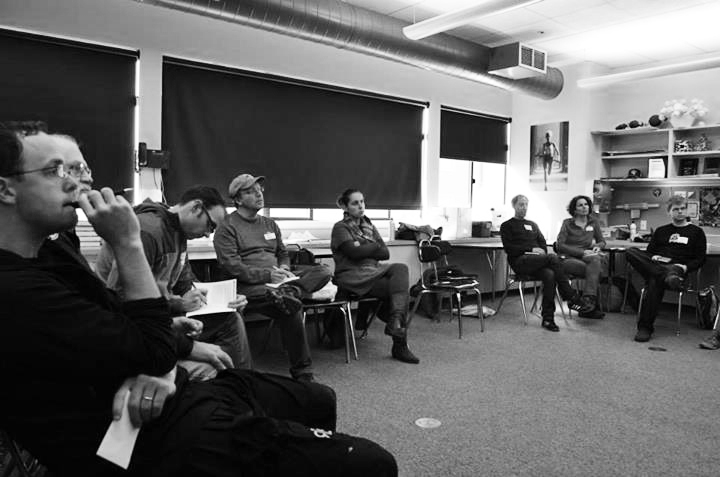
Who first introduced you to ultimate? A large portion of ultimate players are first exposed to the sport by physical education teachers. Over the years, USA Ultimate has made different references available to PE instructors. Mike Lovinguth, USAU’s Youth and Education Programs lead, spoke at the Bay Area Disc Association’s Youth Ultimate Coaching Conference concerning his approach to PE curriculum design. What sets apart his curriculum is the concept of working from a blank slate.
Right off the bat, Lovinguth got his audience thinking deeply about what PE curriculum needs to accomplish. USAU’s membership is proportionally lacking in youth divisions. From USAU’s perspective, they would like to offer more competition in this realm. PE curriculum is one aspect of youth programing that has been indicated in developing more complete youth ultimate players, and “next year’s Olympians”.
Curriculum, specifically, is a framework and needs to be adaptable to different ages, K through 12. Ideally, it should be a reference for PE teachers that can take a young girl or boy, who has never thrown a disc, and keep them engaged through a series of lessons that build on each other. Lovinguth outlines five attributes of successful curriculum:
- Dynamic. Curriculum is a framework that changes to suit teachers and students.
- Categorical. Lovinguth’s curriculum breaks down ultimate into nine major skill sections.
- Systematic. Fundamental skills are taught first. Concepts build on previous skills.
- Evaluative. Teachers use rubrics to evaluate skills.
- Universal. Curriculum needs to work for all ages and sub-populations of kids (e.g. gender, special needs, etc).
Lovinguth’s presentation then became interactive, guiding the audience through a conceptual curriculum design. We considered, “what would be the first thing you teach [a young player] about ultimate?” Catching and throwing come to mind first. Flight of the disc is often what we love most about the sport. For safety reasons, Lovinguth points out that it’s better to start with catching. A broken nose can easily dissuade a young eight-year-old from ever going near a disc again.
Lovinguth continues in this vein, logically unfolding the elements of the game. Once you teach kids to open up space on the field by stacking their offense, what can the defense do to compete? They can use the mark to force throws to only some of that new space. Furthermore, Lovinguth’s emphasis on the specific incentives that are driving kids to move forward in his curriculum were very compelling. For example, after catching and throwing, kids will find that using these skills are more rewarding when challenged by a mark. This is an excellent time to introduce pivoting, Lovinguth explains. Subsequently, defense and cutting are introduced next. With “kids running around, D’ing one another” it becomes time to explain spirit of the game and rules.
Another modern tool available to PE teachers is the J-Star disc. Lovinguth had nothing but good things to say about the 145 gram disc, speaking to the benefits of teaching elementary school kids to throw with smaller discs. “Their hands just aren’t big enough at that age,” Lovinguth explained. Coaches at YUCC this year received a complimentary J-Star in their welcome packet. The J-Star has been gaining traction among elementary school coaches and players and is available through USAU and Discraft.
Reading into Lovinguth’s method, we can compare his approach with previous iterations of USAU’s PE curriculum. Traditionally, these curricula emphasize showcasing the unique elements of the sport to kids on day one, like spirit of the game. While SOTG may be the hook for some kids (and teachers), introducing the game with SOTG violates the systematic approach to Lovinguth’s curriculum. Conversely, some PE teachers may want to introduce their kids to the game in it’s entirety before jumping into systematic skill lessons. Perhaps the modern reality is that kids who want to play are coming into PE, already knowing about ultimate, following the lead of upperclassmen. As ultimate visibility has increased, Lovinguth’s curriculum may be the ideal approach for PE instructors at schools with established ultimate programs. Moreover, it may be a sign that ultimate is becoming more accepted in PE classes as a sport versus a mini-game, and this curriculum is starting to address real skill building.








Comments Policy: At Skyd, we value all legitimate contributions to the discussion of ultimate. However, please ensure your input is respectful. Hateful, slanderous, or disrespectful comments will be deleted. For grammatical, factual, and typographic errors, instead of leaving a comment, please e-mail our editors directly at editors [at] skydmagazine.com.